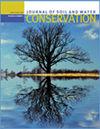美国东南部按地理区域划分的森林道路网沉积物输送比和采伐作业特征
IF 2.6
4区 农林科学
Q2 ECOLOGY
引用次数: 0
摘要
机械化的森林采伐和相关的通路网络会加速土壤侵蚀。森林水质最佳管理规范(BMPs)用于最大限度地减少森林作业造成的土壤侵蚀,并在河流进入之前在现场捕获被侵蚀的物质。泥沙淤积对水质构成多重威胁,但研究表明,bmp在减少侵蚀方面通常是有效的。然而,BMP在减少特定操作特征(滑轨、甲板、收获区、河流交叉点和运输道路)和区域沉积物方面的有效性还没有充分量化。泥沙输送比(SDRs)是评价bmp效率和效果的必要指标。SDR是到达溪流的侵蚀沉积物的比例(或百分比)。土壤侵蚀模型和沉积物捕获应用于弗吉尼亚州和北卡罗来纳州山区、皮埃蒙特和沿海平原地区58个最近收获的183个操作特征,以确定特别提款权。在所有地区,河流过境点的平均sdr最高(34%),其次是滑道(21%)、运输道路(16%)和甲板(4%)。收获领域(不包括访问功能)的sdr平均为11%。SDR值按地区加权,沿海平原的SDR加权值最高(19%),其次是山区(13%)和皮埃蒙特(6%)。东南地区所有地区和业务特征的总体平均SDR为12%,与之前报道的值一致。高度可变的特别提款权受到场地条件、气候因素和跨场地BMP实施范围的影响,但仍制定了合理的估计。主要建议包括额外强调河流穿越、滑轨和河滨管理区(SMZ) bmp。本文章由计算机程序翻译,如有差异,请以英文原文为准。
Sediment delivery ratios from forest road networks and harvesting operational features by physiographic region in the southeastern United States
Mechanized forest harvesting and associated access networks can accelerate soil erosion. Forestry best management practices (BMPs) for water quality are used to minimize soil erosion from forest operations and to trap eroded materials on-site before stream entry. Sedimentation provides multiple threats to water quality, but research indicates that BMPs are generally effective at reducing erosion. However, BMP effectiveness for reducing sediment from specific operational features (skid trails, decks, harvest areas, stream crossings, and haul roads) and regions is insufficiently quantified. Sediment delivery ratios (SDRs) are needed to evaluate efficiencies and effects of BMPs. SDR is the ratio (or percentage) of eroded sediment that reaches streams. Soil erosion modeling and sediment trapping were applied to 183 operational features on 58 recent harvests across the Mountains, Piedmont, and Coastal Plain regions of Virginia and North Carolina to determine SDRs. For all regions combined, mean SDRs were highest for stream crossings (34%), followed by skid trails (21%), haul roads (16%), and decks (4%). Harvest areas, not including access features, had SDRs averaging 11%. SDR values were weighted by areas, and the highest weighted SDR was for the Coastal Plain (19%), followed by the Mountains (13%) and Piedmont (6%). The overall average SDR for all regions and operational features across the southeast was 12%, which corresponds with previously reported values. The highly variable SDRs were influenced by site conditions, climatic factors, and a wide range of BMP implementation across sites, yet reasonable estimates were developed. Major recommendations include additional emphases regarding stream crossing, skid trail, and Streamside Management Zone (SMZ) BMPs.
求助全文
通过发布文献求助,成功后即可免费获取论文全文。
去求助
来源期刊
CiteScore
4.10
自引率
2.60%
发文量
0
审稿时长
3.3 months
期刊介绍:
The Journal of Soil and Water Conservation (JSWC) is a multidisciplinary journal of natural resource conservation research, practice, policy, and perspectives. The journal has two sections: the A Section containing various departments and features, and the Research Section containing peer-reviewed research papers.

 求助内容:
求助内容: 应助结果提醒方式:
应助结果提醒方式:


